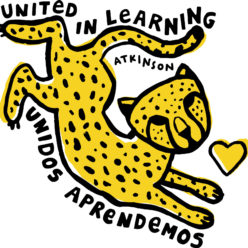Weeds
One person’s weed is another person’s wildflower. For example, purple aster was selected to plant in the Wildlife Habitat; however it reproduces abundantly and requires weeding. If a dandelion grows next to a pepper plant in a classroom bed, it is taking nutrients and water from the pepper plant and is called a weed, yet dandelions might be valued as a nutritional salad ingredient at another site.
At Atkinson, it is best to play it safe and only eat plants that have been cultivated in the classroom beds. While some may know how to identify lamb’s quarters, chickweed, mallow, purslane and wood sorrel for tasting, there is a chance that a plant might not be properly identified.
Three Weeds
Scientific plant identification is based on the morphology of flowers and fruits, but other features may come into play. It is helpful to have a hand lens when identifying plants.
Oregon’s Official Weed Management Department lists the three weeds pictured below on their list of noxious weeds. All are currently growing on Atkinson’s grounds.
Himalayan BlackberryRubus procerus
Wear gloves, as this plant has prickly stems. Dig deeply to get roots out. Do not compost. |
Canada ThistleCirsium arvense
An aggressive perennial weed with a deep underground root system. Dig out deeply when young. Be vigilant; it may take 2-3 years to get rid of. Do not allow to go to seed. Best weeded by older students or adults. Do not compost. |
Field BindweedConvolvulus arvensis
This plant looks like morning glory. It has an extensive root system. Dig or pull these out with great care, as small pieces of root left in ground will take root again. Do not compost. |
Weeding Tips
Weed after watering. This will make removal of the roots much easier. If the soil around the root of the weed is dry, chances are the root is dry also and therefore more likely to break.
Weed early in spring. Soil is wet and weeds are small. Early weeding will cut down on what you have to do later in the season.
Remove as much of the root as possible. It may be easier to use a trowel to dig out the weeds. If the root remains in the ground, maintenance may be more difficult in the future.
Make weeding into a game to inspire greater interest. Be certain that students are knowledgeable about what a weed is, and what a desired native plant is. This is especially important when young plants are sprouting, as they are difficult to identify. Pick an example of a popular weed in the garden and place it in a bucket. Give each child a bucket with a different weed (or pair of students if necessary). Have the kids weed for a certain period of time (10 minutes is a pretty good span) and then compare the relative abundance of each weed. Have a conversation about why some weeds grow larger or more prolifically than others.
Keep some “wild” in the Wildlife Habitat. This native plant garden is a learning laboratory for what happens in nature. It’s a fine balancing act, because we must also keep sight lines open. The wildlife habitat is not intended to be tidy, just as nature is not tidy. Keep some nesting materials (dried out vegetation) accessible for birds and other small creatures. Do not cut back ferns unless they are crowding out other desirable plants or overgrowing the paths. Many of the flowers are host plants for butterfly larvae; do not remove vegetation if you find a chrysalis. Leave fruits and berries on the plants when possible, so students can observe the entire life cycle of plants.
Selective composting of weeds. The school compost pile may not heat up sufficiently to fully break down weed material, so it is a good idea to keep problematic weeds and their seeds out of the compost pile (see “Weeds” section). Weeds that are not composted may be put in large paper bags and placed in dumpsters by the service entrance.



